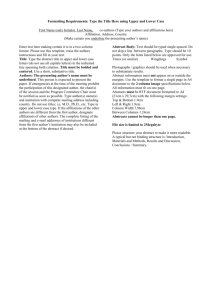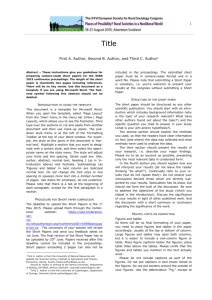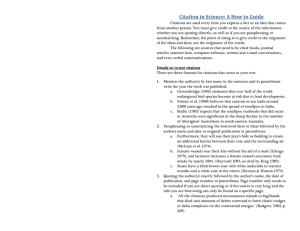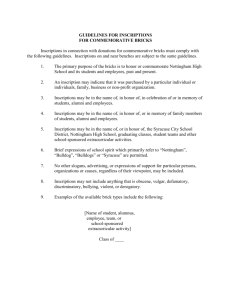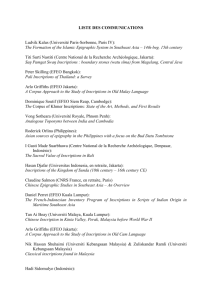Guidelines document
advertisement
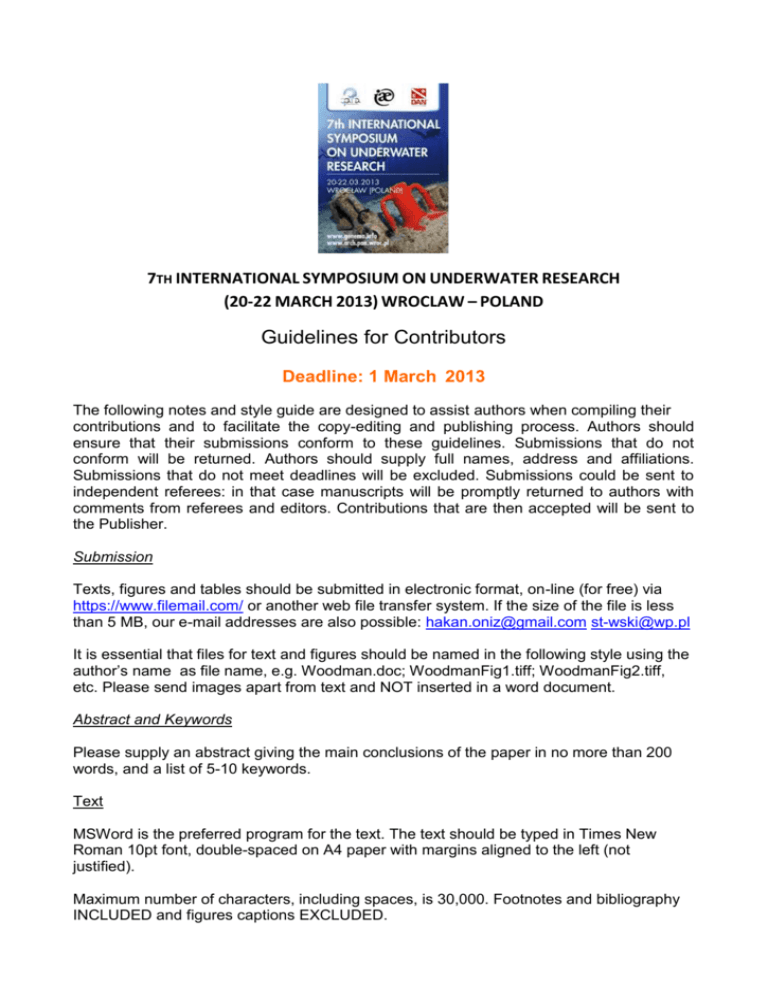
7TH INTERNATIONAL SYMPOSIUM ON UNDERWATER RESEARCH (20-22 MARCH 2013) WROCLAW – POLAND Guidelines for Contributors Deadline: 1 March 2013 The following notes and style guide are designed to assist authors when compiling their contributions and to facilitate the copy-editing and publishing process. Authors should ensure that their submissions conform to these guidelines. Submissions that do not conform will be returned. Authors should supply full names, address and affiliations. Submissions that do not meet deadlines will be excluded. Submissions could be sent to independent referees: in that case manuscripts will be promptly returned to authors with comments from referees and editors. Contributions that are then accepted will be sent to the Publisher. Submission Texts, figures and tables should be submitted in electronic format, on-line (for free) via https://www.filemail.com/ or another web file transfer system. If the size of the file is less than 5 MB, our e-mail addresses are also possible: hakan.oniz@gmail.com st-wski@wp.pl It is essential that files for text and figures should be named in the following style using the author’s name as file name, e.g. Woodman.doc; WoodmanFig1.tiff; WoodmanFig2.tiff, etc. Please send images apart from text and NOT inserted in a word document. Abstract and Keywords Please supply an abstract giving the main conclusions of the paper in no more than 200 words, and a list of 5-10 keywords. Text MSWord is the preferred program for the text. The text should be typed in Times New Roman 10pt font, double-spaced on A4 paper with margins aligned to the left (not justified). Maximum number of characters, including spaces, is 30,000. Footnotes and bibliography INCLUDED and figures captions EXCLUDED. Maximum number of pages for IMAGES is 3. Insert only one space after full stops, NOT two (use the ‘show nonprinting character’ command in word = ). Please do not supply text with embedded illustrations (submit them as separate individual files via FILEMAIL or another file transfer system, see above). Please avoid superscripts ‘6th’ in 6th, 8th, etc. If your program does this automatically please SWITCH IT OFF (in Word go to Tools, Autocorrect, Autoformat as you type). Language The official language of the 17th SOMA is English. It is of paramount important that the final version of the submitted paper is thoroughly read and corrected by a native English speaker. If the paper fails to be written in a proper manner, correct grammar and spelling, the paper will not be accepted and will not be published. Fonts Avoid long quotations in different alphabets and transliterate where possible. If you do need to use specific fonts (for example for Ancient Greek, Hieroglyphics, Cyrillics etc.) please contact the Editors hakan.oniz@gmail.com st-wski@wp.pl Headings and sub-headings Type these in upper and lower case characters, NOT all in capitals, e.g., Conclusions, not CONCLUSIONS). Use Bold for the top level, Italics for the second level and ordinary type for the third level. Spelling and abbreviations UK or US spellings are acceptable. BC and AD (no punctuation) - also for upper case abbreviations / acronyms (UK, USA etc.) e.g., i.e., cf., etc. (fullstops but no italics) et al. and c. (italics and fullstops) No fullstops after abbreviations such as m (=metre), cm (=centimetre), cms (=centimeters) and other abbreviations of measurements No space should be used between a number and its unit of measurement, e.g., 98cm Leading zero before measurements and numbers that are less than 1, thus 0.56 rather than.56, and so on Numbers Numbers from one to ten should be spelled out; higher numbers should be given in numerals, e.g., 11, 235, etc. No comma should be used for numbers with fewer than five digits, e.g., 5000, NOT 5,000; but 10,000. Contractions Contractions which end with the same letter as the original word do not take a full stop as in for example Dr (not Dr.), Mr (not Mr.), eds (not eds.) etc. Dates Give centuries and millennia as, for example: 5th century BC, 2nd century AD etc. For specific years, the letters BC should follow the date, preceded by a space (e.g. 490 BC); the letters AD should precede the date, also with a space between the two (e.g. AD 499). If the date is approximate, indicate this with ‘c.’ followed by a space and the date; in this case both BC and AD follow the date (for example, c. 733 BC; c. 353 AD). Use hyphenation only adjectivally (for example, ‘in the 6th century’ but ‘a sixth-century temple’). Please note also the following forms: Thursday, 12 November 1966 1960s (not 1960’s) 1547-9; 1382-1420; 1910-18 Italics Italics should be used for foreign words or transliterations. Please note that the surrounding punctuation should not be italicised. Exceptions to the use of italics are: when the word is part of a foreign language quotation when the word has already been sufficiently assimilated into the English language Quotation marks Use single quotation marks throughout, with double marks for a quotation within a quotation (e.g. ‘text text “text” text text’). Displayed quotations have no quotation marks. Any quotations within a displayed quotation should carry single marks. Figures, tables and captions Number illustrations, figures, photos and tables in one sequence and refer to them all as Figures. Do not use ‘Table’ or ‘Plate’. AVOID sub-numbering such as Figure 7a, Figure 7b, call them Figure 7 and Figure 8. Capitalise and do not abbreviate ‘Figure’ in the text. Ensure that there is a numbered reference to each figure and table in the text. List all captions at the end of the article AFTER the Bibliography, or in a separate file. Referencing Papers must be in Harvard style referencing. For Harvard style (author and date, page number) followed by end-of-chapter bibliographies see the following: ‘according to Bloggs (1966, 31) it seems ...’ or ‘it has been stated (Bloggs 1966, 31) that ...’. Note the use of a comma between the date and page number/s, NOT a colon. Multiple citations should be in alphabetical order and separated by a semi-colon, e.g., (Affleck et al., 1988; Bahn and Pettitt 2003; Wymer 1982). Where an author has several publications from the same year, distinguish them as a, b etc (eg.1998a, 1998b). Do not use ‘ibid’. Where footnotes are used, they should be numbered sequentially in Roman superscript numerals,single spaced, 10pt. Avoid using footnotes where possible and keep footnote material to a minimum. Do not use endnotes. Examples of the required bibliography format are given below. Please ensure that all references are complete. Use a comma rather than a colon between volume and page numbers. DO NOT use bold for volume numbers. For all citations and bibliographic references, spell out ‘and’ between multiple authors and editors, do not use ‘&’. Use full stops after initials in authors’ names and make sure there are spaces between them as well. Thus for example, use M. S. F. Hood, and NOT M.S.F. Hood or MSF Hood. Note that for an international audience all journal and series titles must be written out IN FULL, e.g., ‘International Journal of Osteoarchaeology’, NOT ‘Int. J Osteo.’, and ‘British Archaeological Reports’, NOT ‘BAR’. In multinational volumes even the most familiar archaeological abbreviations may be confusing to other people. Thesis Bottema, S. 1974. Late Quaternary Vegetation History of North-Western Greece. Unpublished PhD thesis, University of Groningen. Journal article Cruise, G. M. 1990. Pollen stratigraphy of two Holocene peat sites. Review of Paleobotany and Palynology 63, 299–313. Book Lamb, H. H. and Tessier, L. 1987. Weather, Climate and Human Affairs. London, Routledge. Edited book Fairbairn, A. S. (ed.) 2000. Plants in Neolithic Britain and Beyond. Oxford, Oxbow. Section in book Foster, I. D. L. and Grew, R. 1990. Magnitude and frequency of sediment transport in the Po valley.In J. Boardman (ed.), Soil Erosion of Agricultural Land, 36–56. New York, Wiley. Section in book with multiple editors Frayer, D. W. 1997. Ofnet: evidence for a Mesolithic massacre, in D. L. Martin and D. W. Frayer (eds.), Troubled Times: Violence and Warfare in the Past, 181-216. Amsterdam, Gordon and Breach. Section in book if editor unknown Serre-Bachet, F., Guiot, J. and Tessier, L. 1992a. La dendroclimatologie; pour une historie du climat. In Les veines du temps. Catalogue d’exposition, 93–119. Paris, Musée du Monde. Ancient authors, inscriptions and Greek lettering Use the New Athena Unicode font for Greek (free to download from http://apagreekkeys.org/NAUdownload.html). Transliteration of Greek words and names. In the transliteration of Greek, most Latinate forms of Greek words or proper names that have come into general use may be employed. Authors are at liberty to use any system of transliteration that is intelligible and reasonably consistent, although the editors reserve the right to modify it to conform to current AJA editorial policy. Authors who wish to do so may follow the system recommended in AR 45 (1998–1999) inside cover. Systems for the transliteration of other languages may be found in Manual of Foreign Languages, 4th ed. (G.F. von Ostermann [New York 1952]). References to classical literature. Latin titles are preferred, italicized according to the list of abbreviations given inThe Oxford Classical Dictionary, 3rd rev. ed. (S. Hornblower and A.Spawforth, eds. [Oxford 2003]; hereafter OCD3), followed by the appropriate book, chapter, paragraph, or line numbers, separated by periods. Any author/work not abbreviated in OCD3 should be spelled out in full. Authors’ names and titles should be written in full when appearing in the text and abbreviated when appearing in notes or parenthetical references within the text. Capitalization of works should follow that in OCD3: As noted by Vitruvius (De arch. 2.3.3) Vitruvius notes in De architectura (2.3.3) 1 Vitr., De arch. 2.3.3 Inscriptions. Inscriptions should be marked according to the Leiden system, as outlined in The Study of Greek Inscriptions, 2nd ed. (A.G. Woodhead [Cambridge 1981] 6–11) and Conventions in Editing: A Suggested Reformulation of the Leiden System (S. Dow [Durham 1969]). Inscriptions quoted within the text should be written with a division of lines corresponding to those on the stone: Inscriptions of 50 words or fewer and inscriptions appearing in notes may be written continuously, with a single upright line ( | ) used to mark the beginning of each line and a double upright line ( || ) used to indicate the beginning of every fifth line: Inscriptions in corpora are cited using Arabic numerals only by inscription number, without page references, the abbreviation “no.,” or intervening periods/commas: IG 22 65 line 23 CIL 1(2) 327 Figures and tables The volume layout will be in two columns for text, and in one or two columns for figures (including tables and photos). Thus there is the option of having figures the width of either one column (80 mm width) or two columns (170 mm width). Prepare figures accordingly, and be sure to indicate intended size if not provided in the correct size (for example a large photograph). All artwork should be provided electronically if possible (scanned etc.), but may also be provided as hard copy. All figures will be printed in black and white. Print out electronic images and graphs and check them before submission and provide a hard copy print-out (in addition to any electronic version) for checking purposes. The following file types are acceptable for figures: Excel or Word Use for tables with sans-serif font (such as Arial), preferably in point size 9, and no less than 8 (to bring the table within the width of the printed page). Excel Charts and graphs should be designed to appear in black and white. Use patterns to distinguish bars on graphs, etc. rather than colour or tone, which looses clarity when printed in black and white. Adobe Illustrator Convert to black and white; do not submit in colour. If using versions earlier than 9 please make sure that all fonts are embedded or included on the disk, or save them as a .pdf file. Adobe Photoshop All formats are acceptable. pdf files Use high resolution only. Embed all fonts and do not compress images when distilling. TIFF, EPS These are the preferred formats for scanned images. Scan photographic prints at 600 dpi, slides at 1200 dpi. Scan black and white line artwork at 600 dpi. Scan mixed line and tone illustrations at 600 dpi. (JPEGS are acceptable if saved to maximum quality.) Submit the image in the size it is intended to appear. Copyright The editorial board and the publisher will assume that the authors have obtained permissions (including photographs, etc. for illustrations) where necessary. Permissions are the author’s responsibility, not that of the editorial board or publisher. Authors are kindly requested to take care of reproduction fees, if any. ONLINE REFERENCING (Source: the American Journal of Archaeology) References to files on websites. The list of works cited should contain full citations to the home page of a website and may include other pages, files, links, paragraphs, or graphics. The basic format for citing electronic sources in the reference list is as follows: Author’s Last Name, Initial(s) or Maintainer or Sponsoring Institution. Year, date of publication or last update. “Title of Document.” Title of Site or Journal Name, volume number (year) [if applicable]. URL. Sample references to electronic media in list of works cited. The reference list entry is given first, followed by a sample note entry: Home page of a website Lavan and Gering (2009) within the text;in bibliography: Lavan, L., and Gering, A. 2009. Kent-Berling Ostia Excavations.http://lateantiqueostia.wordpress.com. Secondary page of a website in bibliography: Lavan, L., and Gering, A. 2010, 26 November. “Bones Bring a New Story.” Kent- Berling Ostia Excavations. http://lateantiqueostia.wordpress.com. Article in an online journal Iverson, P. 2008, 3 September. “Virtual Seminar on Some Unpublished Inscriptions from Corinth IX.” Current Epigraphy. www.currentepigraphy.org/2008/09/03/virtual-seminar-onsomeunpublished- inscriptions-fromcorinth-ix/. Online PDF Yeganehshakib, R., and Rezakhani K. 2009. “Sasanian Chemical Warfare? A Scientific Re-Assessment.” Sasanika. www.humanities.uci.edu/sasanika/pdf/Sasanian%20Chemical%20Warfare.pdf. Online graphic Crane, G., (ed.) 1997, S eptember. The Perseus Project. www.perseus.tufts.edu/cgibin/ image?lookup=1991.09.0760. www.genama.info



